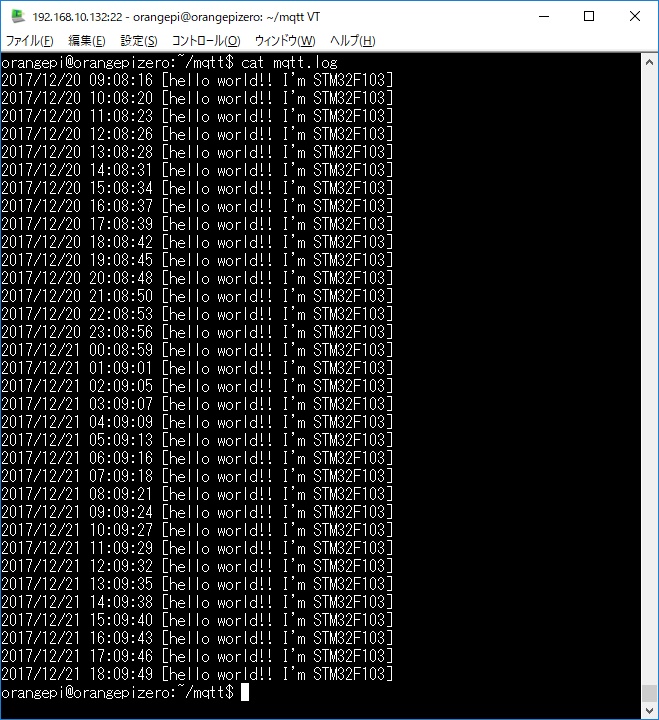/*
STANDBY mode時のタイマー精度を測定する
PIN Connections (Using STM32F103):
W5X00 - STM32F103
---------------------
VCC - 3.3V
GND - GND
SS - Pin PA4
SCLK - Pin PA5
MISO - Pin PA6
MOSI - Pin PA7
RST - PullUp
*/
#include <SPI.h>
#include <Ethernet_STM.h> //
https://github.com/rogerclarkmelbourne/Arduino_STM32
#include <PubSubClient.h> //
https://github.com/knolleary/pubsubclient
#include <STM32Sleep.h> //
https://github.com/chacal/stm32sleep
#include
<RTClock.h>
// https://github.com/rogerclarkmelbourne/Arduino_STM32/
#define MQTT_SERVER
"192.168.10.40"
//#define MQTT_SERVER
"broker.hivemq.com"
//#define MQTT_SERVER
"iot.eclipse.org"
#define MQTT_PORT 1883
#define MQTT_KEEP_ALIVE 60
#define MQTT_PUB_TOPIC "stm32f103/STANDBY" // You
can change
#define MQTT_WILL_TOPIC "stm32f103/STANDBY" // You can
change
#define MQTT_WILL_MSG "" // You can change
#define STOP_BUTTON PB0 // 0:
Disable STOP_BUTTON
#define RUNNING_LED PB1 // 0:
Disable RUNNING_LED
#define ALARM_SECOND 3600
// Enter a MAC address for your controller below.
// Newer Ethernet shields have a MAC address printed on a
sticker on the shield
#if defined(WIZ550io_WITH_MACADDRESS) // Use assigned MAC
address of WIZ550io
;
#else
byte mac[] = {0xDE, 0xAD, 0xBE, 0xEF, 0xFE, 0xED};
#endif
EthernetClient ethClient;
PubSubClient pubsubClient(ethClient);
RTClock rt(RTCSEL_LSE);
static void noop() {};
void errorDisplay(char* buff) {
int stat = 0;
Serial.print("Error:");
Serial.println(buff);
while(1) {
if (RUNNING_LED) {
digitalWrite(RUNNING_LED,stat);
stat = !stat;
delay(100);
}
}
}
void setup() {
unsigned long Time1;
unsigned long Time2;
Time1 = millis();
delay(1000);
Serial.begin(9600);
pinMode(STOP_BUTTON,INPUT);
int wk = digitalRead(STOP_BUTTON);
if (wk) {
while(1) {
Serial.println("HALT!!");
delay(1000);
}
}
if (RUNNING_LED) {
pinMode(RUNNING_LED,OUTPUT);
digitalWrite(RUNNING_LED,LOW);
}
// start Ethernet and UDP
#if defined(WIZ550io_WITH_MACADDRESS)
if (Ethernet.begin() == 0) {
#else
if (Ethernet.begin(mac) == 0) {
#endif
errorDisplay("Failed to configure
Ethernet using DHCP");
}
Serial.print("My IP: ");
Serial.println(Ethernet.localIP());
Serial.print("Netmask: ");
Serial.println(Ethernet.subnetMask());
Serial.print("GW IP: ");
Serial.println(Ethernet.gatewayIP());
Serial.print("DNS IP: ");
Serial.println(Ethernet.dnsServerIP());
pubsubClient.setServer(MQTT_SERVER, MQTT_PORT);
char clientid[30];
IPAddress ip = Ethernet.localIP();
Serial.print(ip[0]);
Serial.print(".");
Serial.print(ip[1]);
Serial.print(".");
Serial.print(ip[2]);
Serial.print(".");
Serial.println(ip[3]);
sprintf(clientid,"STM32-%03d",(int)ip[3]);
Serial.print("clientid=");
Serial.println(clientid);
Serial.print("Attempting MQTT connection...");
// Attempt to connect
if
(!pubsubClient.connect(clientid,MQTT_WILL_TOPIC,0,0,MQTT_WILL_MSG))
{
errorDisplay("connect Fail");
}
Serial.println("connected");
char payload[50];
snprintf (payload, 75, "hello world!! I'm
STM32F103");
Serial.print("Publish message: ");
Serial.println(payload);
if (!pubsubClient.publish(MQTT_PUB_TOPIC, payload))
{
errorDisplay("publish fail");
}
Time2 = millis();
Serial.print("Timee2 - Time1=");
Serial.println(Time2-Time1);
int procTime = (Time2-Time1)/1000;
Serial.print("procTime=");
Serial.println(procTime);
rt.createAlarm(&noop, rt.getTime() +
ALARM_SECOND - procTime);
goToSleep(STANDBY);
}
void loop() { } // This is never run
|
